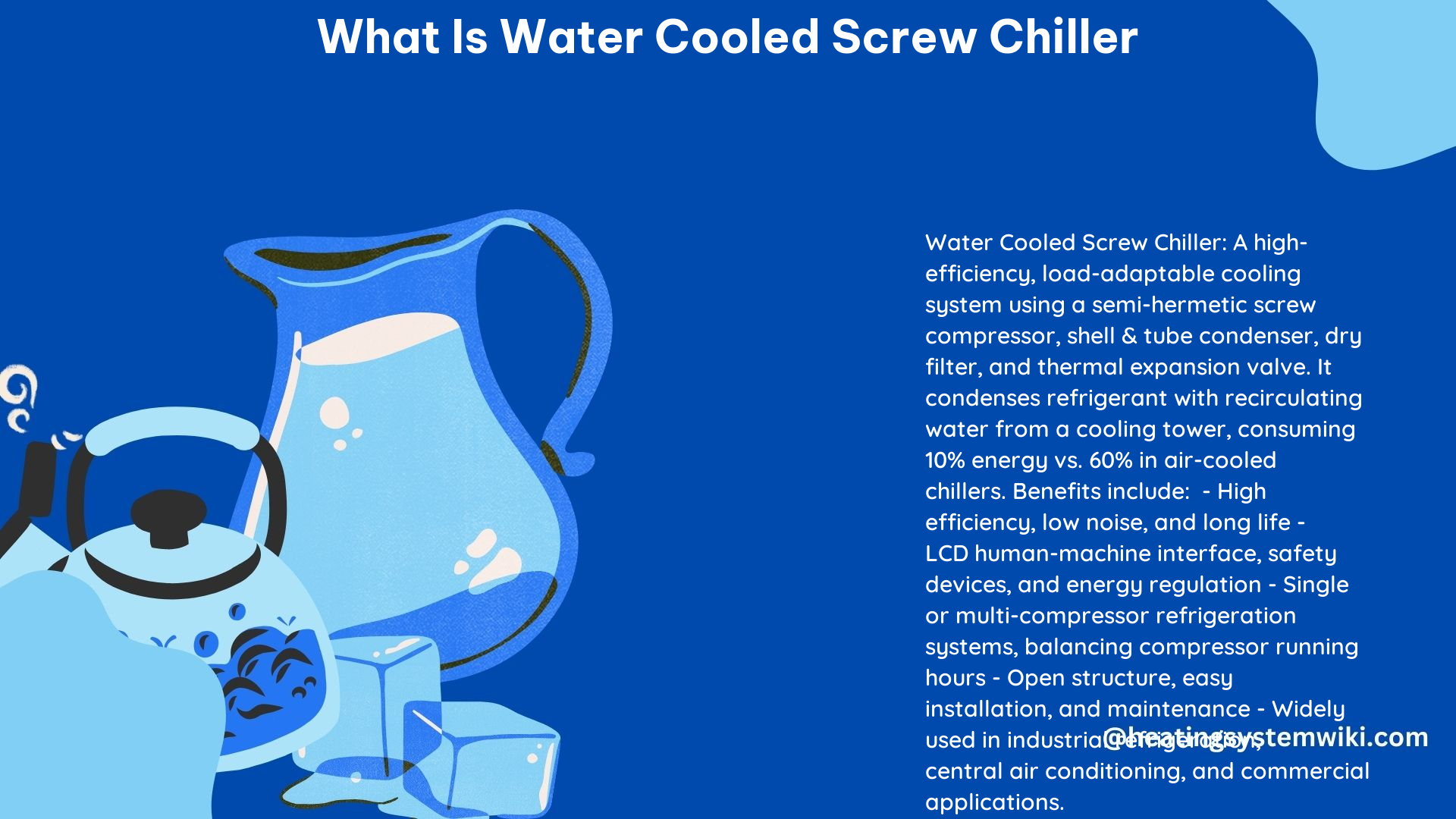A water-cooled screw chiller is a highly efficient cooling system that utilizes recirculating water from a cooling tower for heat exchange, offering significant energy savings compared to air-cooled chillers. These chillers are widely employed in various industrial and commercial applications, including plastics, electroplating, electronics, chemical, pharmaceutical, printing, food processing, large shopping malls, hotels, factories, and hospitals, to provide reliable and energy-efficient cooling solutions.
Working Principle of Water-Cooled Screw Chiller
The working principle of a water-cooled screw chiller involves a series of thermodynamic and refrigeration processes:
-
Compression: The low-pressure, low-temperature refrigerant vapor is compressed by the semi-closed screw compressor, transforming it into a high-pressure, high-temperature gas.
-
Condensation: The high-pressure, high-temperature gas enters the shell and tube condenser, where it is cooled down and condensed into a high-pressure liquid by exchanging heat with the recirculating cooling water.
-
Expansion: The high-pressure liquid refrigerant then passes through a thermal expansion valve, which reduces its pressure and temperature, turning it into a low-pressure, low-temperature liquid-vapor mixture.
-
Evaporation: The low-pressure refrigerant is then sent to the shell and tube evaporator, where it absorbs heat from the water or air that needs to be cooled, evaporating into a vapor.
-
Recirculation: The vaporized refrigerant gas is re-absorbed by the compressor and discharged into the condenser, creating a continuous cooling cycle.
System Composition of Water-Cooled Screw Chiller

The typical system composition of a water-cooled screw chiller includes:
- Semi-Closed Screw Compressor: A high-efficiency, semi-hermetic twin-screw compressor that compresses the refrigerant vapor.
- Shell and Tube Condenser: A heat exchanger that condenses the high-pressure, high-temperature refrigerant gas by exchanging heat with the recirculating cooling water.
- Dry Filter: A filter that removes any impurities or moisture from the refrigerant.
- Thermal Expansion Valve: A valve that reduces the pressure and temperature of the refrigerant, turning it into a low-pressure, low-temperature liquid-vapor mixture.
- Shell and Tube Evaporator: A heat exchanger that allows the low-pressure refrigerant to absorb heat from the water or air that needs to be cooled, evaporating it into a vapor.
- Electrical Control Part: A programmable logic controller (PLC) that manages the operation and control of the chiller.
Unique Advantages of Water-Cooled Screw Chillers
- Higher Energy Efficiency: Water-cooled screw chillers are approximately 10% more energy-efficient than air-cooled chillers, which typically have an energy consumption of around 60%.
- Improved Condensation: Water-cooled screw chillers can condense water better than ambient air, leading to higher energy efficiency and lower energy consumption, making them an excellent choice for high-rise buildings and industrial applications that require large-scale cooling systems.
- Durability and Long Lifespan: Water-cooled screw chillers are known for their durability and long lifespan, providing a cost-effective cooling solution for businesses and organizations.
Technical Specifications of Water-Cooled Screw Chillers
- Cooling Capacity: Ranging from 35 Tons of Refrigeration (TR) to 1000 TR.
- Compressor: High-efficiency, semi-hermetic twin-screw compressor.
- Evaporator: Dry type shell and tube evaporator heat exchanger.
- Compressor Configuration: Single compressor to four compressors.
- Chiller Type: Vertical and horizontal configurations available.
- Expansion Device: Thermostatic expansion valve for throttling.
- Control System: PLC programmable controller.
- Heat Recovery: Option for heat recovery function.
- Capacity Control: Segmented or multi-stage continuous capacity adjustment for precise temperature control.
- Refrigerants: R22, R134A, R407C, R410A, R510A, and other eco-friendly refrigerants.
DIY Tips for Water-Cooled Screw Chiller Installation and Maintenance
- Water Flow and Pressure: Ensure proper water flow and pressure to maintain efficient heat exchange in the condenser.
- Cooling Tower Maintenance: Regularly clean the cooling tower to prevent buildup of debris and maintain optimal performance.
- Refrigerant Level Checks: Regularly check the refrigerant levels and top up as needed to ensure the chiller operates at its peak efficiency.
- Manufacturer Guidelines: Follow the manufacturer’s instructions and recommendations for installation, operation, and maintenance to ensure the longevity and optimal performance of the water-cooled screw chiller.
- Professional Consultation: Consult with experienced HVAC professionals for guidance on the selection, installation, and maintenance of water-cooled screw chillers to ensure the system is properly sized and configured for your specific application.
By understanding the working principle, system composition, unique advantages, and technical specifications of water-cooled screw chillers, you can make an informed decision and ensure the efficient and reliable operation of your cooling system.
